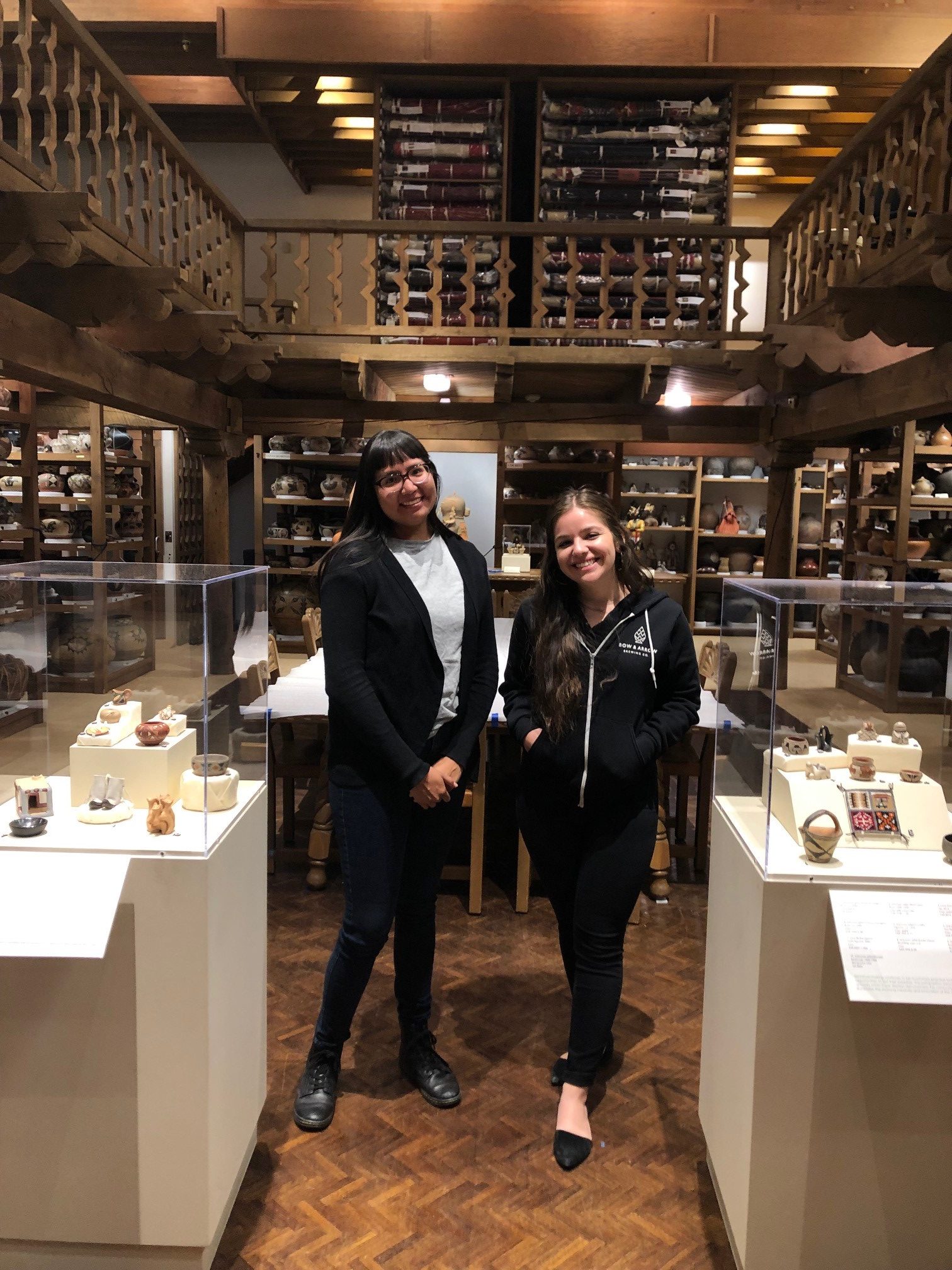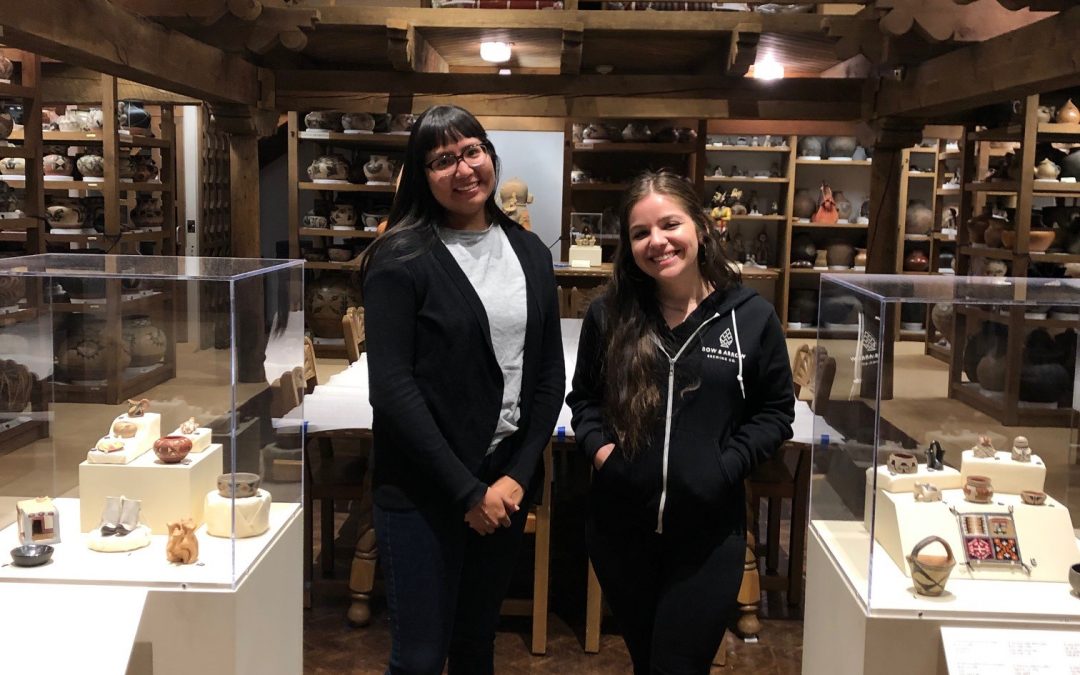Felicia Garcia and Samantha Tracy have a noticeable synergy. When I sat down to talk with the 2018–2019 Anne Ray interns at SAR’s Indian Arts Research Center (IARC), I was struck by how well they complemented one another: Garcia (Samala Chumash) has studied education and curation in a museum context, focusing on Indigenous land acknowledgments, whereas Tracy (Diné) has worked mostly in collections management and care. During their nine months at the IARC, they have strengthened their skills in these areas and others, and they have also become collaborators, learning from one another as they shared knowledge, skills, and ideas.

What do you think has been the most interesting or exciting thing about your work here?
FG: I’ve never had a collections internship, so getting to work hands-on with the pieces here has been really fun for me. We’ve done a lot of custom mount-making for the smaller works in the vaults. I was really bad at it at first—I think I’m OK now—but it’s just been fun to be trusted to do that kind of work and to learn those kinds of new skills that if I stayed on the same track of education and curatorial work I would never have the opportunity to learn.
ST: Yeah, mine is totally the opposite: I’ve learned how to handle a lot of objects, but the education part was never really something I thought about within the museum world. Now, with SAR, they’re working with local schools here in Santa Fe in integrating art within the afterschool programs and working with the children. And I really enjoy that. I really like working with the kids and taking what we know and educating them and just working together. So I’m really thankful for that part, getting into the education part of museums.

You mentioned taking something back to your communities. Can you talk more about that?
ST: Every time I go back [to Fort Defiance] that’s all I think about: the schools and how could I take what I’m learning and work with these kids. I definitely want to go think about it more and talk to these teachers and instructors so I can figure out what I should be doing.
FG: My tribe is building a cultural center right now, and it’s my hope to work there eventually. Something that I’ve been thinking about a lot is how that space can serve both my community as in my reservation and the Native people in my town and how it can also serve the larger non-Native community because the California state curriculum is really lacking in terms of what it has to say about the Native California peoples. I feel like SAR is a really good model and the Indian Arts Research Center really serves both Indigenous and non-Indigenous communities with the artist fellowships and the community consultations and then also the public tours and seminars. I think there’s a really good balance here, and I think that I’ll definitely be able to pull from this experience in trying to navigate that in the future and creating programming that serves two different communities and maybe can bridge that gap between the two.
Is that something you [Samantha] have thought about in terms of your community?
ST: I just really want the younger kids to understand that there’s more to art than just traditional styles and everything, and that’s something I really want to push forward and work with them on. You know, create anything that you want and we have this good resource here at the [tribal] museum with the collections. Take a look at that and go from there. Create something different.


Has there been anything surprising about working with the collection?
FG: I guess I never really thought about how much decolonizing theory can apply to collections management. I thought about it a little bit in terms of repatriation and things like that, but watching the kinds of projects that Lisa [Barrera, collections manager] and Lily [Jones, collections assistant] do has created a better understanding of collections care for me. There have been a couple of instances where Lisa really thought about a particular artist and their work—say they were from a certain pueblo but then married into another pueblo. Thinking about which of those two is the right place for their work and that kind of care and thought is—I didn’t realize that that could go into a collection and the way that you organize it. So that’s definitely something I’ll take with me and think about when I work for my cultural center in the future: not just things organized by size or function but those kinds of more abstract ways of thinking about a collection.
Can you talk more about decolonizing, how it relates to this kind of work, or how you want to use it in your own work?
FG: I guess for me I think decolonizing really requires an entirely new way of thinking about museums and collections stewardship and sometimes it’s really hard to conceptualize what decolonizing means. I had no idea what decolonizing would mean for the care of a collection and organizing it, but I think at the Indian Arts Research Center, they’re creating new ways of doing things that might not work for all institutions but are a decolonizing approach that works for this particular institution. I think it just involves being really creative and taking in the opinions of the communities that are represented and challenging the way that things have been done previously in museums. I think that Lisa does a really great job of coming up with new ideas for organizing and taking care of the collection here.


How do you think your experience here will help you with your future work and goals?
FG: I’m just really grateful to have gotten experience in collections management and registration and I think that having experience in those different parts of museum work has made me a more well-rounded emerging professional. I’m on the job hunt right now, and I’ve submitted a lot of applications, and I’ve found myself in interviews speaking about how working with collections here, working with the database, will contribute to my skill set, and I’ll be able to bring that to future positions.
ST: The databases are definitely interesting to learn because a lot of the places where I volunteered, there are all these different databases, programs, and stuff. I totally geeked out on it: “This holds so much information compared to any of the other databases that I’ve worked with!” So that was one thing that definitely I want to learn more about. Databases are really interesting for me.
You’re making connections in all these different ways, and it’s helping you, and it’s helping SAR—do you have any advice for future interns?
ST: I think just enjoy your time being here and asking so many questions and taking advantage of the collections and learning about the different regions and getting familiar with the styles of the Southwest and all the pueblos that are represented in there. It’s a very fun experience.
FG: Also take advantage of all the different things that are happening outside of SAR in Santa Fe. I probably could just stay on campus all the time because it’s beautiful and there’s plenty of things to do around here, but I have really enjoyed going to the different events at the Museum of Contemporary Native Arts or going to the different gallery openings and getting to know other folks in the art community in Santa Fe. More specifically, the Native art community here is just so amazing, and it doesn’t exist in New York. I never had that.
ST: Volunteer. That was one of the things I took from IAIA. One of my instructors said, “Always volunteer, always give your time, and you’ll go from there.” So I’ve really appreciated that I’ve volunteered at these places here in Santa Fe to make the working connections and connections with museum people and artists alike. So, do a lot of volunteering, it’s fun.


Reproductions of Beatien Yazz’s animal illustrations curated by Garcia and Tracy and displayed in SAR’s Administration Building.
Do you have any last thoughts about being at SAR, how you think it will help you, what you think you’ll take with you?
FG: I think something else that’s really amazing about this internship is that the network is larger than just Samantha and I or the people that are on campus now. It’s this huge community of people, something that you can’t really get anywhere else, and it’s a really great resource to have all these people who are in your community because of SAR. So I’m really thankful for that and excited to continue to have those relationships and meet new people from the SAR community as I go through my career.
ST: I totally agree with that. Just getting to know the people who are here in this institute and getting to build that relationship with everyone and having the same interests with the museum field, but also the work that we do outside in terms of working with SAR and doing artist outreach and internship outreaches. We get to connect with the people who are familiar with SAR, so we already have that connection of knowing the institute and knowing the collection. It’s just like a big family every time we see someone familiar or they notice that we’re interns. I’ve definitely had that experience, I’m sure we’ve both had them. That’s something I’m really thankful for is getting to know a lot of people, really good people, really good artists, good donors.
(This interview has been edited for clarity and length.)
Learn more about the Indian Arts Research Center internship program here.
You can see the 2018–2019 Anne Ray interns’ exhibits, along with the other treasures of SAR’s campus, by taking one of our historic estate tours.
